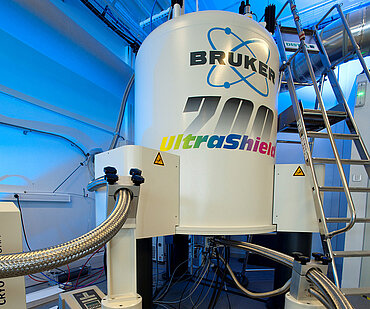The Nuclear Magnetic Resonance platform recycles its helium
IGBMC's Nuclear Magnetic Resonance platform is equipped with a system that recycles the liquid helium used for its high-field and high-sensitivity spectrometers. This ingenious device will make it possible to save nearly 700 m3 of gaseous helium per year and to guarantee the proper functioning of the platform, by reducing the impact of international tensions related to the supply of this resource.

Helium, a crucial resource for research and industry
Helium is obtained from the exploitation of underground gas pockets as a by-product of oil extraction. Helium is a strategically important gas in industry and research. Its importance stems from its ability to reach the temperature of -272°C in its liquid state, a crucial characteristic for Nuclear Magnetic Resonance Spectroscopy (NMR).
NMR requires the liquid samples to be analysed to be placed in an extremely strong magnetic field, about 360,000 times the earth's magnetic field. Such a high magnetic field value can be achieved with an electric magnet made of a superconducting material. With superconductivity, electrical resistance disappears and allows a very high current to flow through the magnet coil. As the magnetic field is proportional to the intensity of the electric current, the latter can reach very high values. This superconducting effect is achieved by placing a magnet at a temperature close to absolute zero, i.e. -273°C.
To trigger this superconducting effect, the magnet coil is immersed in a bath of liquid helium, close to absolute zero, in an NMR spectrometer.
An installation to reduce the need for liquid helium renewal
Liquid helium evaporates naturally into the atmosphere at a rate of 850 000 litres of gas per year. A regular replenishment of liquid helium must be carried out every 3 to 6 months. The IGBMC's NMR platform obtains its liquid helium from Unistra's Cryogenics Department. The latter has the competence for helium liquefaction and was equipped in 2017 with a new helium liquefier.
With the installation of the 700 MHz spectrometer in 2010, joining the two other spectrometers at 500 and 600 MHz, it became necessary to optimise the consumption of liquid helium for the NMR platform of the IGBMC.
In 2010, prof. Bruno Kieffer, director of the Biomolecular NMR team at the IGBMC, obtained funding from the European programme French Infrastructure for Integrated Structural Biology (FRISBI) for the installation of a helium recovery and compression station. This unit was installed in 2018 thanks to the company Girodin-Sauer as well as the expertise of the Cryogenics Department staff, the IGBMC technical services and the Biomolecular NMR laboratory staff, who carried out the installation.
Liquid helium, a resource under pressure
For several years now, the price of helium gas has been on the rise, from €6.20 per m3 in 2015, the current rate is €27 per m3... Thus, in 3 years of use, the recovery installation has enabled savings on the purchase of helium gas of nearly €40 k. For the year 2021 alone, the savings will amount to 16 k€.
At a time when the global supply of helium is becoming difficult due to technical problems at the main production site in Texas and uncertainty about the possibility of obtaining supplies from the Russian market, the second most important supplier of helium, it appears that the helium recovery project was a visionary investment. It allows the sustainability of the NMR platform of the IGBMC when many laboratories in the country have difficulties in meeting the operating costs of the NMR spectrometers and the difficulties of supply on the helium market. It is also a sustainable development investment as it allows the preservation of the helium resource which is being depleted.
